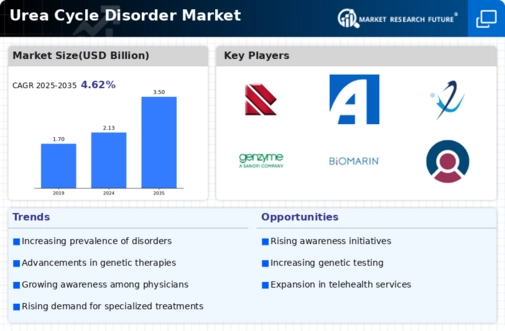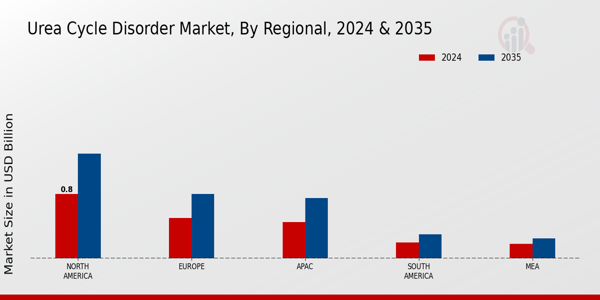Innovations in Gene Therapy
Innovative advancements in gene therapy are emerging as a pivotal driver for the Urea Cycle Disorder Market. Recent developments in gene editing technologies, such as CRISPR, hold promise for treating genetic disorders, including UCDs. These therapies aim to correct the underlying genetic defects responsible for the disorder, potentially offering long-term solutions. The market is witnessing a surge in research and clinical trials focused on gene therapy applications, which could revolutionize treatment paradigms. As these therapies progress through regulatory pathways, the Urea Cycle Disorder Market may see a shift towards more effective and targeted treatment options, enhancing patient quality of life.
Enhanced Diagnostic Technologies
The advancement of diagnostic technologies is a crucial driver for the Urea Cycle Disorder Market. Improved screening methods, such as tandem mass spectrometry and genetic testing, are facilitating earlier and more accurate diagnoses of UCDs. These technologies enable healthcare providers to identify affected individuals promptly, which is essential for effective management and treatment. The increasing availability of these diagnostic tools is likely to lead to higher detection rates, thereby expanding the patient population in need of therapeutic interventions. Consequently, the Urea Cycle Disorder Market is expected to grow as more patients are diagnosed and treated, highlighting the importance of timely intervention.
Growing Investment in Rare Disease Research
The increasing investment in research and development for rare diseases is significantly influencing the Urea Cycle Disorder Market. Governments and private organizations are allocating substantial funds to understand and treat rare genetic disorders, including UCDs. This financial support is fostering innovation and accelerating the development of new therapies. For instance, the Orphan Drug Act has incentivized pharmaceutical companies to invest in treatments for rare diseases, leading to a rise in the number of clinical trials. As a result, the Urea Cycle Disorder Market is likely to benefit from a pipeline of novel therapies aimed at addressing unmet medical needs.
Increasing Prevalence of Urea Cycle Disorders
The rising incidence of Urea Cycle Disorders (UCDs) is a notable driver for the Urea Cycle Disorder Market. Recent estimates suggest that UCDs affect approximately 1 in 35,000 live births, indicating a growing patient population. This increase in prevalence necessitates enhanced diagnostic and therapeutic options, thereby propelling market growth. As awareness of genetic disorders expands, more individuals are being diagnosed, which further contributes to the demand for specialized treatments. The Urea Cycle Disorder Market is likely to experience significant growth as healthcare providers focus on early detection and management of these conditions, leading to improved patient outcomes and increased healthcare expenditures.
Rising Demand for Specialized Nutritional Products
The growing demand for specialized nutritional products tailored for patients with Urea Cycle Disorders is emerging as a significant driver for the Urea Cycle Disorder Market. These products are designed to manage dietary protein intake, which is crucial for individuals with UCDs. As awareness of dietary management increases, healthcare providers are recommending specific nutritional formulations to support patient health. The market for these specialized products is expanding, driven by the need for effective dietary interventions. This trend indicates a shift towards comprehensive care strategies that encompass both medical and nutritional management, thereby enhancing the overall treatment landscape within the Urea Cycle Disorder Market.


















Leave a Comment